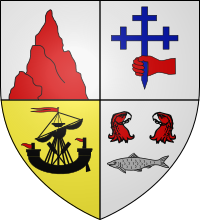Sir Fitzroy Maclean, 8th Baronet facts for kids
Quick facts for kids
Sir Fitzroy Jeffreys Grafton Maclean
|
|
|---|---|
 |
|
| 24th Clan Chief 8th Baronet 4th Lord Maclean |
|
| In office 1818–1847 |
|
| Preceded by | Sir Hector Maclean, 7th Baronet, half-brother |
| Succeeded by | Sir Charles Fitzroy Maclean, 9th Baronet, son |
| Personal details | |
| Born |
Fitzroy Jeffreys Grafton Maclean
c. 1770 |
| Died | 5 July 1847 (aged 77) |
| Spouse | Elizabeth Kidd |
| Parent | Donald Maclean of Brolas |
| Relatives | Sir Hector Maclean, 7th Baronet, brother; Donald Maclean, younger son |
Sir Fitzroy Jeffreys Grafton Maclean was an important leader of the Scottish Clan Maclean. He was the 24th Clan Chief and also the 8th Baronet of Morvern. He lived from about 1770 to 1847. Sir Fitzroy became the Clan Chief in 1818 after his half-brother, Sir Hector Maclean, passed away without any children to take his place.
Contents
About Sir Fitzroy Maclean
His Family Background
Sir Fitzroy Maclean was the half-brother of Sir Hector Maclean, the 7th Baronet. Both brothers were sons of Donald Maclean of Brolas. Donald Maclean had two marriages. His first wife was Mary Dickson, and his second wife was Margaret Wall.
Fitzroy was the son from Donald Maclean's second marriage. Their father, Donald Maclean, was the great-grandson of Donald MacLean, who was the first Laird of Brolas. A "Laird" is a Scottish term for a landowner.
A Long Military Career
Sir Fitzroy began his military journey on September 24, 1787. He started as an "ensign" in the twenty-ninth regiment. An ensign was a junior officer rank. He quickly moved up through the ranks in the army.
He became a Lieutenant in 1788, then a Captain in 1793. By 1795, he was a Major, and later that year, a Lieutenant-Colonel. He continued to rise, becoming a Colonel in 1803 and a Major-General in 1810.
His military career continued, and he became a Lieutenant-General in 1814. Finally, he reached the highest rank of General on January 10, 1837. This shows he was a dedicated and successful soldier.
Important Military Missions
In 1793, Sir Fitzroy was part of the British forces that captured the island of Tobago. He also took part in an attack on Martinique, another island in the Caribbean.
In 1803, he was put in charge of a group called "the Batavians." These soldiers joined the British army when the Dutch West India colonies surrendered. During a mission to capture Surinam, he led the main group of the army.
In 1805, he helped capture the Danish islands of St. Thomas and St. John. He was then made the governor of these islands in 1808. He stayed in this important role until 1815.
Governor and Leader
As governor, Sir Fitzroy was known for being fair and kind to everyone. People from all parts of the islands liked him very much. When he left his post, everyone was sad to see him go.
For his brave actions during the capture of the island of Gaudaloupe in 1810, he received a special medal. He was allowed to wear this medal as a sign of his courage.
Later Life and Family
In June 1815, Sir Fitzroy returned to Europe. He had spent almost 28 years serving in the hot climate of the West Indies. After returning, he mostly lived in London.
In 1794, he married Elizabeth Kidd, who was the widow of John Bishop of Barbados. They had several children together, but sadly, most of them passed away when they were very young.
Only two of his sons lived to adulthood: Sir Charles Fitzroy Maclean, 9th Baronet, who was born in 1798, and Donald Maclean, born in 1800. His first wife, Elizabeth, died in 1832.
On September 17, 1838, Sir Fitzroy married Frances, who was the widow of Henry Campion. Sir Fitzroy Maclean passed away on July 5, 1847. His son, Charles, then became the next Baronet and Clan Chief.

